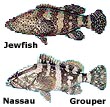The Grouper By Buck Davidson The four stout rods set off the stern bend against the resistance offered by the thick-lipped plugs digging their way through the indigo-blue Gulf waters. You watch two frigate birds wheeling overhead, wondering what the boat looks like from way up there. Your guide pulls your attention back to the 5 inch LED screen of the sonar unit perched on the dash. "Good spot just ahead - 6, maybe 8 foot ledge. Get ready to grab the rod. Caught some big ones here last week." With one eye on the trolling rods you watch the sonar's indicator line slope sharply upward, then down again - outlining the underwater mini-mountain below. You also note several arch-shaped flashes around the peak. Your guide's reaction is immediate : "All right, there they are - now if one's hungry..." The rest of his thought will be lost forever as the port side rods both bend double. You grab the nearest rod and set the hook - and it sets back, lurching your arms forward and burying the rod's butt into your midsection. You swear you've hooked bottom, but the heavy surge you feel on the other end of the line tells you otherwise. The fishing rod you thought more closely resembled a pool cue when you first saw it this morning now seems terribly frail against the awesome power of the struggling fish. The tackle and your back muscles hold out, though, and after a pitched battle your guide sinks a gaff into what's to become the feature attraction at tonight's supper table: a 22 pound black grouper. Red Grouper
Black groupers and gags are frequently confused with one another, but there is no mistaking the strawberry-red coloration of the red grouper. Young specimens especially are often beautifully marked with varying shades of crimson, red and maroon. The inside of the fish's mouth is scarlet-orange. Red grouper occupy areas of hard rocky bottom both nearshore and offshore - individuals move offshore around the time they reach six years of age. Reds grow to around 40 pounds, but 10-15 pounds is the usual catch. Like most groupers, they are opportunistic feeders, but prefer squid, crustaceans and small fish. Now the tricky part: Gags and black grouper look an awful lot alike - Blacks are darker in coloration and have a concave tail (curves inward toward the fish's head). Is telling the difference important? Not terribly - groupers all have a size limit of 20 inches, with an aggregate limit of 5 fish. If you're seeking a record, of course, the difference becomes vitally important - blacks generally grow larger than gags - 100+ pounds is not unheard-of. Gags generally top out in the 70-75 pound range. Both gags and blacks eat mostly squid and small fishes, but are not above taking a lick at just about anything edible-looking that swims by. How do we hook up with one of these critters? Sometimes it's as simple as dropping a sardine under the boat ramp dock...whack!... 21 inch gag. (Yes, I saw it happen.) Usually, though, pursuing grouper involves a trip into water from 50-120 feet deep. There are times of the year when grouper move quite close to shore, but to consistently take these critters, you really need to have a boat. Once you have that boat, you need to know where to start fishing - groupers love rocky bottom. In the old days, captains would bounce lead weights along the bottom as they drifted. When the weight hit a solid surface, they'd drop the anchor and drop the baits. Another trick was to tie a bar of soap to a weighted line and drop it overboard, letting out line 'til it hit bottom. If the soap came up with sand on it - time to move on; if it came up clean, rocks must be below. Sea turtles cruising the surface meant that there was probably hard bottom nearby - these critters love poking around the rocks as well. This trick isn't used today as much as it probably should be: sea turtles still love rocks, but many fishermen, intent on their GPS, will ignore one of these huge reptiles, unaware that there may be a bounty of fish below. In those bygone days, a captain's ability to find his way back to his favorite glory hole was the stuff of legend and lore. Today, though, things are easier. GPS, LORAN and incredibly accurate bottom sonars have made it relatively simple to find and return to a productive grouper hole miles from the nearest land-based reference point. Captains still guard their log books with a watchful eye, but several books cataloging good fishing spots are available to everyone. Once you're at the spot and anchored, look around... is there bait in the water? which way is the tide running? is the wind a factor? Any turtles local? Tackle needs to be pretty stout: level-wind and trolling reels are the norm, mounted to beefy fiberglass or graphite rods. Reels are spooled with 40 to 80 pound test and drags are tightened down. A grouper's first impulse after the strike will be to head back into his rocky home - you need to stop him before he makes it. Bottom fishermen use 3 to 8 ounce sinkers and bait up with cut fish, squid or small baitfish. Trolling for grouper has become popular recently - use diving plugs that imitate baitfish and slow troll over rock bottom at various depths. Lots of black grouper are taken in relatively shallow water using this method. The bag and size limit changes occasionally, so be sure to check them before you go fishing (click here)
Heavy commercial demand has impacted grouper populations, necessitating bag limits on all species and restriction of certain species. We're including the Nassau grouper and Jewfish here for identification purposes, since they are two species that are now illegal to harvest in Florida. They don't look much like commercial grouper species, but mistakes are sometimes made. If you catch one of these fellas, release him immediately...please. Future generations (grouper and human) will reap the benefit. That's it for grouper - keep in touch with us for more details on how to fish for these delectable critters. In salute to the grouper's culinary excellence, I'm throwing in a little bonus with this profile, so here goes nothing. Local seafood restaurants here on the Suncoast all have their own version of a grouper sandwich - some good, some bad. For you prospective visitors to our little piece of paradise, I thought I'd offer my recommendations on the best spots to sample this wonderful creation. (If you don't catch your own, that is...) Second place is a tie between Cooter's Restaurant and Frenchy's Saltwater Cafe on Clearwater Beach. (They're right next door to one another - try 'em both). Standing alone (currently) in first place is Dockside Dave's in Madeira Beach. Dave also makes a stop-you-in-your-tracks grouper chowder. Most unusual: Molly Goodhead's in Palm Harbor for their grouper reuben. A lot of good grouper sandwiches made here, Buck thinks these are the best - take it for what it's worth. Hope you enjoyed it - tight lines. Conservation history about grouper in the Gulf, Click Here..... |
Florida Saltwater Fishing in the Gulf of Mexico


 This game fish profile actually spotlights three different fish: The black grouper, red grouper and the gag. When a Suncoast fisherman heads out to go grouper fishing - or "digging", as it is often called - these are the targeted species. Each makes its home around rock piles, ledges, pilings, shipwrecks, reefs - in short nearly every type of bottom structure. It's not unheard of to have sizable grouper living under the floating dock at the boat ramp. Blacks, reds and gags more or less hang around together, and the same area of structure may hold all three species. They also share an even more desirable feature: groupers are fabulous table fare, especially when prepared fresh from the water. The flesh has a delicate flavor and is very flaky in texture. Let's look quickly at all three critters, then talk about how to bring one home for dinner.
This game fish profile actually spotlights three different fish: The black grouper, red grouper and the gag. When a Suncoast fisherman heads out to go grouper fishing - or "digging", as it is often called - these are the targeted species. Each makes its home around rock piles, ledges, pilings, shipwrecks, reefs - in short nearly every type of bottom structure. It's not unheard of to have sizable grouper living under the floating dock at the boat ramp. Blacks, reds and gags more or less hang around together, and the same area of structure may hold all three species. They also share an even more desirable feature: groupers are fabulous table fare, especially when prepared fresh from the water. The flesh has a delicate flavor and is very flaky in texture. Let's look quickly at all three critters, then talk about how to bring one home for dinner. 

